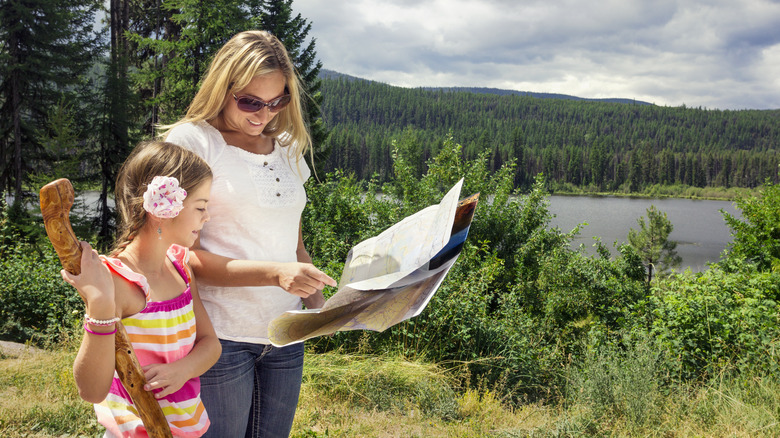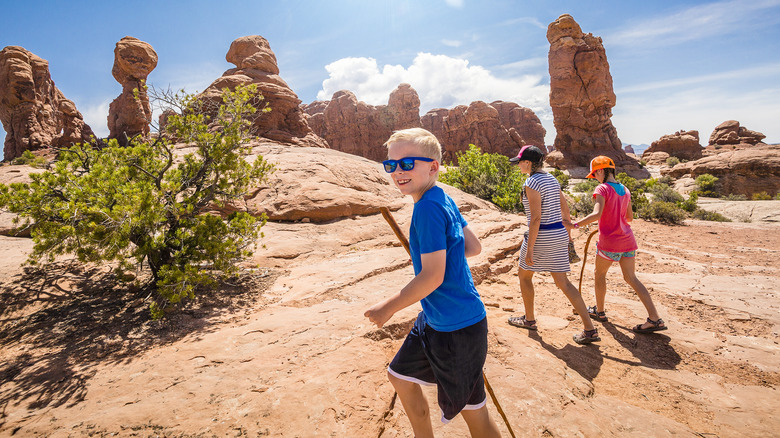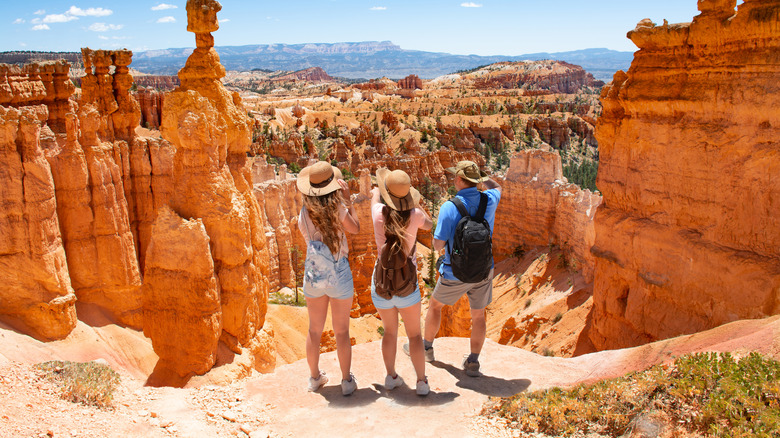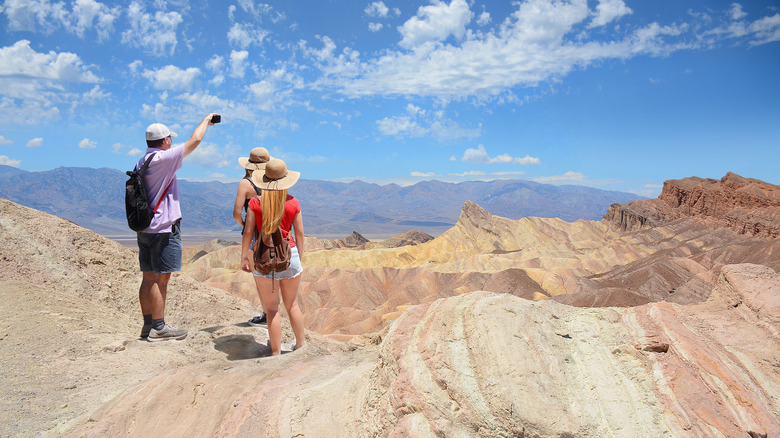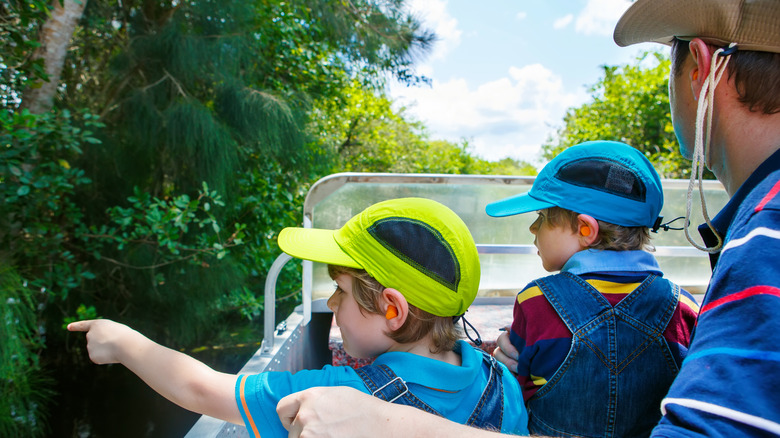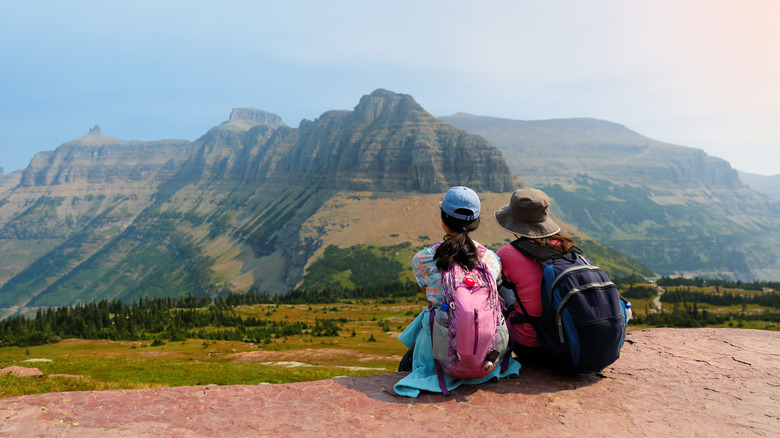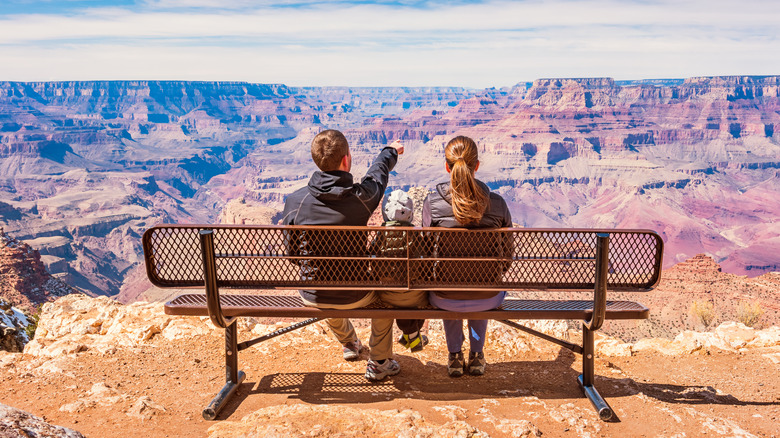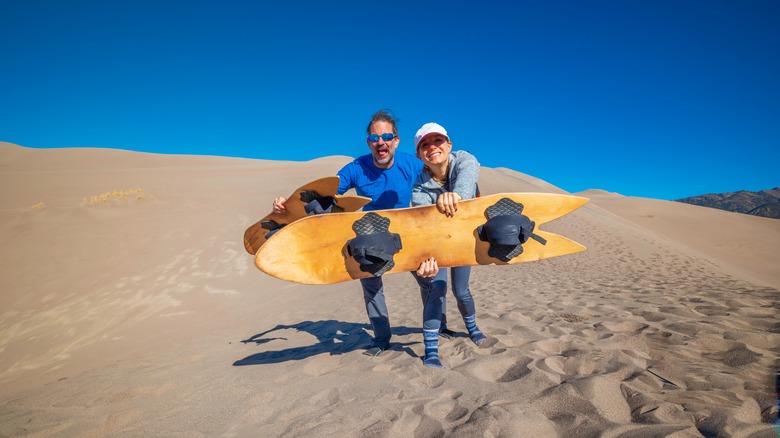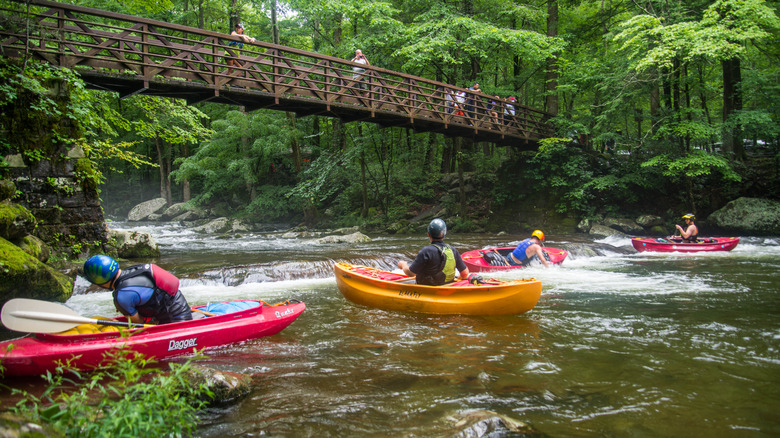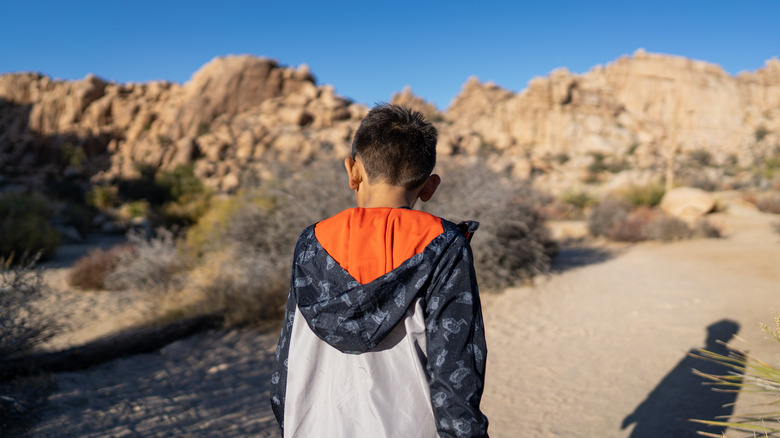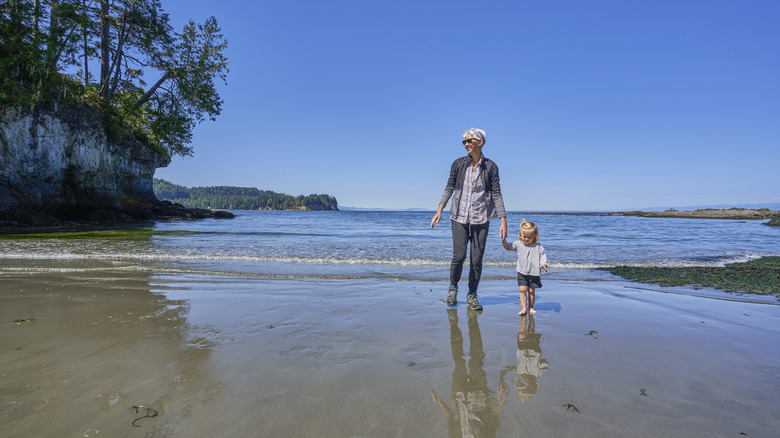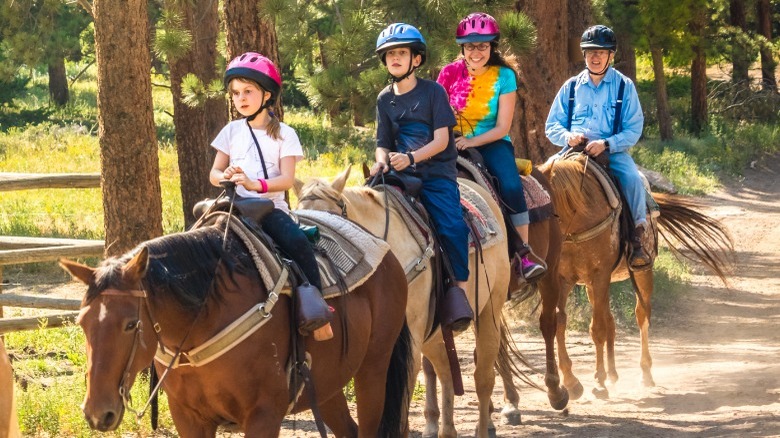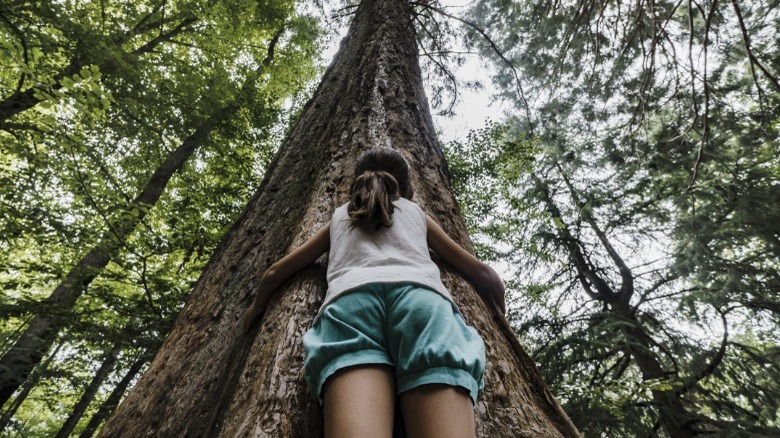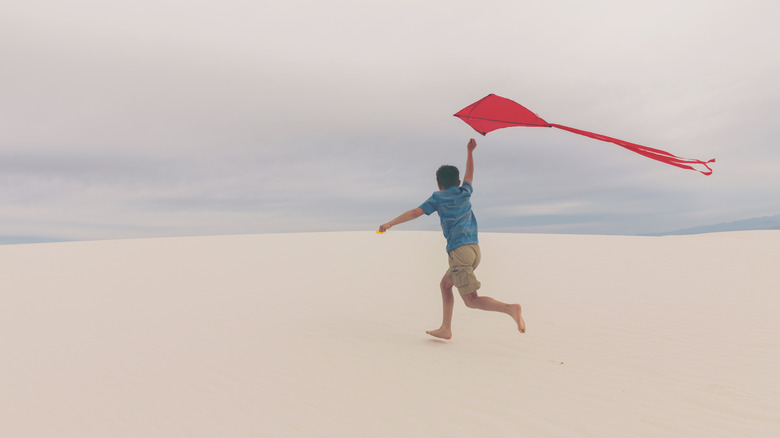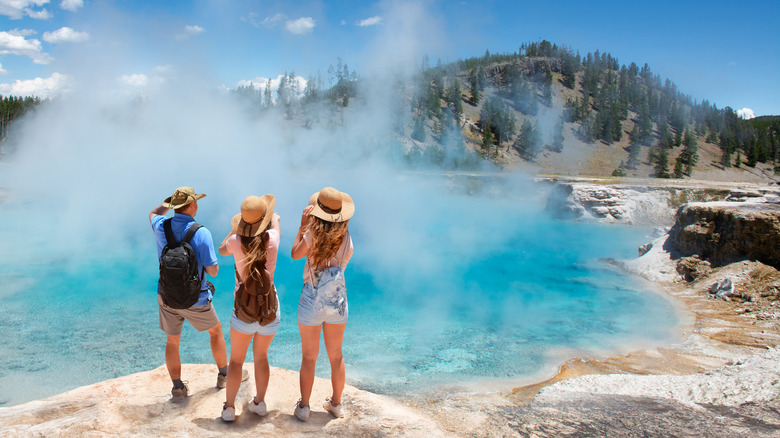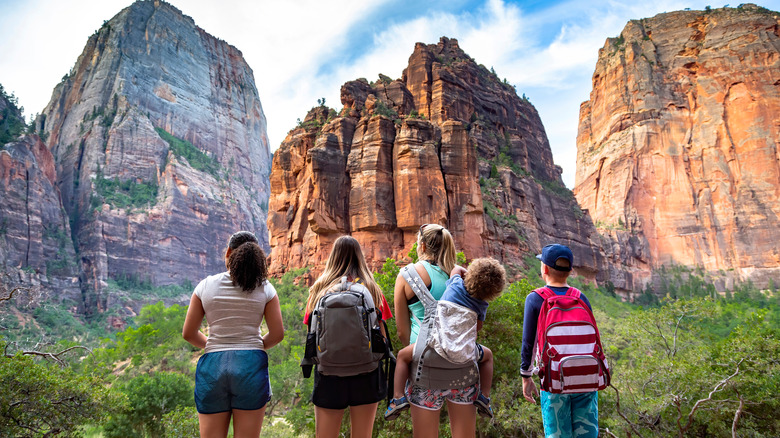15 Best US National Parks To Visit For A Fun, Family-Friendly Vacation
If your idea of a perfect family getaway involves sweeping vistas and wide open blue skies, the hardest part about planning your crew's next vacay might be choosing which of the United States' 63 national parks to add to your travel plans. And you might be surprised to learn just how family-friendly some national parks are between their kid-centric activities and the Junior Ranger program, which lets kids earn merit badges by participating in park activities.
Visiting a national park gives kids a chance to connect with nature and learn about conservation, science, and the natural world around them through family adventures they'll hang onto for a lifetime. To make creating these memories even easier, the National Park system created the Every Kid Outdoors initiative, which lets 4th graders visit national parks for free.
For families planning to visit multiple parks, the America the Beautiful pass is an annual pass that gives holders access to U.S. national parks, interagency-managed lands, and national wildlife refuges, covering the park entrance cost and up to four adults per vehicle. Kids under 15 get in for free with the pass. Whether you're in it for swoon-worthy landscapes or deep woods adventures, there's something for everyone in the U.S. national park system. Hang onto your hiking boots as we take a look at the most family-friendly U.S. national parks.
Arches National Park, Utah
Located adjacent to the Colorado River, Arches National Park is an ethereal dreamscape of natural sandstone arches, balanced rocks, eroded monoliths, spires, pinnacles, towers, massive sandstone fins, and other geological formations. The red rocks contrast against the jewel blue sky to create a near-surreal quality, making for some breathtaking horizons. The park is home to desert critters like antelope squirrels, mule deer, collared lizards, and desert bighorn sheep — not to mention cougars and rattlesnakes. Bring a telescope because, at nightfall, the landscape of yucca, cactus, and desert grass is blanketed in a velvet night sky that provides a simply stunning view of the Milky Way thanks to the absence of light pollution, earning the locale international certification as a dark sky park.
The park features a number of hiking trails for various abilities, including a nature trail and an 18-mile scenic driving tour with commercial tours available if you'd prefer not to do the driving. The park also permits bicycles and pack animals, including burros, mules, and horses. Families can camp at the Devils Garden Campground or grab a picnic at one of the park's many picnic spots. For more adventurous families, rock climbing, canyoneering, and backpacking are on the table. The park website also features a handful of activities to help kids get into the spirit of things. Be sure to kick off your family's visit with a trip to the visitor's center, where you can learn all about the park's flora and fauna.
Bryce Canyon National Park, Utah
When hard rock forms over soft rock, the erosion process can create hauntingly beautiful columns called hoodoos, like those that ornament Paunsaugunt Plateau in Utah. Among the forest of hoodoos and other rock formations at Bryce Canyon National Park, visitors will find a dozen natural hoodoo amphitheaters, stunning pink cliffs, and many other wonders. To help guests see the highlights, the park offers a Hike the Hoodoos program. Park guests can hike 3 miles of the trails and get photos or rubbings of the Hike the Hoodoos; benchmarks are awarded a special prize at the park's visitor center.
The vistas at the park are outstanding, thanks to the high elevation and air quality. With the right conditions, parkgoers can see all the way to eastern Arizona's Black Mesas, 200 miles away. At night, the view goes all the way to the Andromeda Galaxy. The park's wildlife includes 175 kinds of birds, making birdwatching a popular activity for visitors — you can even check out a guide to the park's birds online. Bryce Canyon also features a handful of ranger programs, including the Rim Walk, where rangers educate guests about the park's living ecosystems and history. Evening campfire schedules, a night sky telescope program for park stargazers, and a full moon hike are also among the park's offerings.
Death Valley National Park, California
Living up to its name, Death Valley National Park is an arid, stark, and hauntingly beautiful basin below sea level. As the nation's lowest-elevation national park, Death Valley is known for a vast landscape of salt flats contrasted against lush, vibrant mountains and deep crimson canyons. The park also features some of North America's highest sand dunes, which reach up to 100 feet in height and can stretch for up to 6 miles in length. As one of the driest regions on the planet, Death Valley is home to a host of interesting desert animals — like bighorn sheep, jackrabbits, kangaroo rats, roadrunners, and desert tortoises.
Park guests can choose from a wide selection of activities like hiking, camping, and driving on backcountry and wilderness roads. Fans of "Star Wars" won't want to miss out on the self-guided Star Wars driving tour. The park's many ranger programs include opportunities to learn about borax mining, a sunset walk, and a flintknapping demonstration, among others. You can bring your pet into Death Valley if you follow the park's rules.
Everglades National Park, Florida
For someone who has never been to South Florida, traveling to the Everglades can feel like crossing to another planet. The nation's largest subtropical wilderness ecosystem, the wetlands cover a whopping 1.5 million acres and provide a home to diverse animals, including crocodiles, alligators, dolphins, manatees, and hundreds of bird species like blue herons and spoonbills. Everglades National Park is a vast wildlife preserve comprising coastal lowlands, sawgrass prairies, and mangrove forests — enchanted forests of tangled tree roots growing in the briny water where land meets sea.
The third largest park in the continental U.S., the Everglades offer a host of family-friendly activities like geocaching, canoeing, kayaking, hiking, air boating, tram tours and other guided tours, fishing, bicycling, bird watching, hiking trails, and slough slogging, a type of wet-trail hiking. Depending on how much you like to rough it, visitors can camp in the front country or deep in the Everglades wilderness.
Each of the park's four districts offers a variety of Ranger-led tours. Flamingo District guests can participate in artistic journaling, study the park's flamingos, or learn about the park's Prohibition-era history or Indigenous heritage. Gulf Coast Rangers offer starlight cruises, guided paddle tours, and bayside stargazing. Join Shark Valley's educational wildlife excursions or get your Cold War-era education at the Royal Palms' Nike Missile Site.
Glacier National Park, Montana
Part of an expanse known as the "Crown of the Continent," a vast, 10-million-acre expanse of intact wilderness and wildland, Glacier National Park is one of the country's most enchanted parks. Here, your family can explore pristine lakes surrounded by cascading waterfalls and timeless forests. Learn about the impact of climate change firsthand in the natural habitat of wolverines, marmots, beavers, moose, elk, grizzly bears, and black bears. Take a walk on the South Shore Two Medicine Trail swinging bridge while you're there.
The park offers a Tree Key visitors can use to identify coniferous trees like pines, cedars, and Douglas firs. Glacier Park's Native America Speaks initiative invites Indigenous voices from the Blackfeet Nation and Confederated Kootenai and Salish tribes to share their heritage, culture, and history with hands-on learning, storytelling, singing, and other presentations. The park also provides ranger talks, astronomy sessions, animal Olympics, guided hikes, a historic hotel tour, and children's campfire programs.
One of the park's must-see sights is the Apgar Nature Center, housed in a historic log cabin dating back to Glacier Park's early days. Horseback riding, boat rentals, float trips, bicycle rentals, and camping are also available. Stop by the visitors' center and pick up a free family backpack filled with goodies like binoculars, a compass, and a naturist journal.
Grand Canyon National Park, Arizona
Home to one of the world's most popular natural wonders, 11 federally recognized tribes, and hundreds of species of birds, mammals, and fish, Grand Canyon National Park is a must-see destination that should be on every family's travel bucket list. Stretching over 18 miles at a depth of more than 6,000 feet, the canyon itself inspires awe, reverence, and a sense of humanity's place in the universe.
One of the park's family-friendly highlights is the Hopi House, a 1905 building inspired by 1,000-year-old pueblo dwellings of Old Oraibi, located on the Hopi Reservation near Kykotsmovi Village. Hike around the canyon and check out the vista from spots like Hopi Point, Yavapai Point, or Mather Point.
Camping and lodging are available on the North Rim and South Rim, and the park offers ranger-led experiences, including a 90-minute stroll along the Kaibab Plateau via the Transept Trail. Share in a cultural demonstration at the Desert View Watchtower, visit the geology museum or take a mule ride through the canyon. Grand Canyon Park also hosts a range of fun, kid-friendly ranger programs like the critter chat, geology lesson, or fossil discovery walk.
Great Sand Dunes National Park, Colorado
Located in south-central Colorado, Great Sand Dunes National Park features North America's tallest sand dunes and is home to the world-famous Star Dune, which reaches a height of 755 feet. The park features a 30-square mile dunefield where visitors can sand sled, sandboard, climb, and explore. And since the area features a wide range of dune sizes, the whole family can get into the fun. If someone in your family has a mobility need, the park even offers accessible chairs with wheels meant to roll over the dunes.
Stargazing, fishing, and dune sketching are some of the park's most popular pastimes, and Jeep rentals are available if you want to explore Medano Pass, the park's primitive four-wheel-drive road. The San Luis Valley is home to the majestic Sandhill cranes, whose annual migration is a huge draw for visitors. The park's visitor center is a great place to learn about the park's wildlife, ecosystem, and geology before setting out on your adventures. Pets are permitted in some areas of the park, so be sure to check out a park pet map if you plan to bring the family doggo.
Great Smoky Mountains National Park, North Carolina and Tennessee
If you've always dreamed of exploring enchanted forests straight out of a fairy tale with your little adventures, the Great Smoky Mountains National Park will make you feel like you've been transported to Neverland. So named for the otherworldly haze looming over the mountain forests, the Great Smoky Mountains stretches along the larger Appalachian Mountain Range for about 450 miles, reaching from northwest North Carolina to northeast Tennessee.
With stunning natural features like the Newfound Gap Pass, Cades Cove Valley, Cherokee National Forest, the Roaring Fork Nature Trail, and Black Balsam Mountains, the more than 500,000-acre park is the country's most visited national park. Many forest creatures call the park home, and lucky visitors might see elk, white-tailed deer, wild turkeys, raccoons, or woodchucks. Park guests can walk through historic cabins and other historic buildings, wind through nature trails, camp in the American wilderness, or go ziplining, whitewater rafting, or horseback riding.
Learn about the park's heritage and wildlife at the Oconaluftee Visitor Center, Sugarlands Visitor Center, or Mountain Farm Museum. Smoky Mountain Field School provides educational sessions on everything from Indigenous communities to mushrooms and synchronous fireflies. Ranger-led events include a wildflower pilgrimage each April, a festival showcasing Appalachian music, and several other seasonal events.
Joshua Tree National Park, California
With surreal rock formations and strangely contorted trees, Joshua Tree National Park features a landscape like no other. Arising at the convergence of the Colorado and Mojave desert ecosystems, where millions of years of extreme winds, rains, and desert heat have carved out some of the planet's most stunning terrain, this strange and alien landscape is home to a host of family-friendly activities. The 800,000-acre park takes its name from the eponymous native plant, a type of yucca known for its Seussian shapes and spiked leaves. Park guests can commune with desert creatures like bobcats, roadrunners, and desert lizards while trekking down a backcountry road or exploring the park on horseback.
Stargazing, wildflower viewing, four-wheel drive tours of Geology Tour Road, and tours of the historic Keys Ranch are among the park's more popular activities. Bicycle riding, birdwatching, photography, and geology tours are also popular. Some of the park's ranger-led activities include evening programs at Jumbo Rocks and ranger-led sunset strolls. The family that loves rock climbing is in for a special treat — this park offers more than 4,000 climbing routes suited to a wide range of experience levels.
Olympic National Park, Washington
If choosing a national park to visit leaves you torn between ecosystems, Olympic National Park is your ideal family destination. Spanning nearly a million protected acres, this park features three completely diverse ecosystems, making visits feel more like a journey through Middle Earth than a run-of-the-mill camping trip. Explore the park's alpine meadows with their bountiful wildlife, crisp air, and vibrant display of summertime wildflowers, all in the lee of glacier-capped mountaintops. Travel along 70 miles of wild Pacific coastline with its sea stacks and tide pools, serenaded by seagulls and crashing waves. Or journey into the temperate Pacific Northwest rainforest to find yourself surrounded by a dense forest floor of lush moss under a canopy of ancient trees.
Olympic National Park is a living classroom where visitors can learn to forest edible mushrooms and berries or embark on a ranger-led rainforest walk. The park also offers hiking, camping, wildlife viewing spots, scenic drives, a night-sky astronomy program, and evening campfire programs. Tidepooling is also a popular activity.
Rocky Mountain National Park, Colorado
For the ultimate family camping experience, few spots are a better fit than Rocky Mountain National Park. A 415-square mile park home to the 14,529-foot elevation Longs Peak, Rocky Mountain boasts dozens of lakes and streams, 355 miles of hiking trails, and some of the most scenic drives in the country, including the nation's highest continuous paved road. It also has an embarrassment of riches in wildlife, including mountain lions, moose, bears, and deer. The park's wildlife population also includes a winter elk herd of as many as 600 elk, at least 280 recorded bird species, and around 350 bighorn sheep.
The park features several visitor centers and a nature store, and camping spaces that are simply magical. The Rocky Mountain rangers offer one of the park system's more extensive programming lineups with events that include a stroll around Lily Lake, bird walks, a fire-to-flower walk, wildlife talks, and a family discovery hike. Grab your fishing poles because Rocky Mountain National Park offers some of the best fishing in the country. And horseback rides are also available for guests who prefer a more equestrian experience.
Sequoia and Kings Canyon National Park, California
One of the nation's most awe-inspiring sights, Sequoia and Kings Canyon National Parks are home to giant sequoia trees, some of which have been standing guard over the Sierra Nevada mountains for thousands of years. Along with the alerce and bristlecone pine, these ancient giants are one of the planet's oldest living species. Here, children can reach into the past as they learn to read the secrets hidden in tree rings, examine the relationship between fire and forest health, and learn about trees' relationship to the ecosystem and water cycle. No trip would be complete without a visit to the world's largest living tree, General Sherman, which stands at a striking 275 feet tall with a more than 36-foot diameter.
Once you've finished hugging trees, you can climb Moro Rock to take in its spectacular views. Take a scenic drive through the mountainside, visit one of the park's visitor centers, or explore the Giant Forest Museum. Take a day hike to explore the glaciated valley of Cedar Grove with its dazzling waterfalls, majestic cliffs, and towering rock formations. The park also offers a fine selection of ranger programs, including campfire sessions. Swimming, camping, and picnic spots are also available.
White Sands National Park, New Mexico
Named after the luminescent white gypsum sand and home to the world's largest gypsum dunefield, White Sands National Park is a wonderland like no other. Like a living zen garden of ever-shifting dunes, the strange and haunting landscape may call to mind a glimmering sea of sugar, snow, or finely ground diamonds. The park is in south-central New Mexico's Tularosa Basin and is home to a vibrant array of desert life, including ocotillo, lizards, creosote bush, yucca, and coyotes.
White Sands National Park offers plenty of family-friendly activities, including camping, stargazing, and hiking. The park even has its own kid-friendly mascot in the persona of Riley the Roadrunner, who helps educate kids about the importance of leaving no trace when experiencing nature. Guests can learn about the history of the region, which was first inhabited more than 10,000 years ago by the Paleo-Indian people who arrived when the landscape looked much different. Ranger activities include the Lake Lucero tour, the park's annual MothaPalooza festival, full moon hikes, and sunset strolls. By far, one of the park's most popular activities is sand sledding on saucers you can purchase at the White Sands gift shop.
Yellowstone National Park, Wyoming, Montana, and Idaho
A jewel of the northwestern United States, Yellowstone National Park was the country's first national park when it was first established as one in 1872. This volatile country is a land of contradictions, from its lush forests and towering mountains to the hot springs, mud spots, geysers, and thermal vents created by the hot magma forming a hotspot beneath it. The park is an actively erupting hotspot with more than 10,000 hydrothermal features, including Old Faithful, the renowned geyser visitors have been flocking to from around the world for over 100 years. Among the creatures that call this park home are bears, eagles, wolves, and bison.
Guests can embark on one of the park's scenic drives or explore the park's historic areas. Yellowstone guests who set out on foot can find a wealth of natural features, including waterfalls, mud volcanoes, pools, basins, springs, geysers, lakes, and bays. In addition to the park's ranger activities, Yellowstone offers a Young Scientist program. To participate, young guests five years and older can pick up a self-guided booklet at one of the visitor centers. The program is available for three age groups, and kids who complete the program are awarded a patch or key chain, depending on their age.
Zion National Park, Utah
Known for its steep red cliffs, Zion National Park is a natural wonder painted in vivid autumn colors and surrounded by lush, enchanted forests. Park visitors enjoy ascending Walter's Wiggles — a series of 21 grueling switchbacks — and then hiking to the peak of Angels Landing, a 1,488-foot geological formation with a trail cut into it leading to one of the park's most outstanding vistas. Another popular pastime is canyoneering in the Narrows, a narrow slot gorge in Zion Canyon requiring a waterlogged hike upstream through the Virgin River. Other park highlights include swimming in the waterfalls of the Emerald Pools, taking in the panoramic view at Watchman's Point, and getting to know the local wildlife, including eagles, hawks, deer, and mountain lions.
River trips, stargazing, birdwatching, climbing, biking, backpacking, and camping are all popular diversions at the park. Stop by the Zion Human History Museum to learn about the anthropology of the region, or learn about everything from canyon tree frog calls to bird songs at the Zion Nature Center. The park also features a self-guided ranger program, a campfire program featuring the park ranger's favorite stories, and plenty of other ranger-led adventures.
